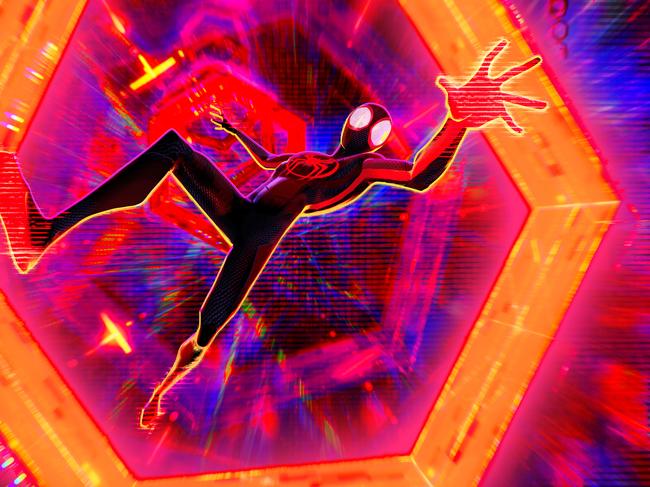The best Spider-Man film ever? Across the Spider-verse dazzles
Animated Spider-Man sequel is worth the price of admission in this four-star movie.

Spider-Man: Across the Spider-Verse (PG)
In cinemas
★★★★
The opening scene of Spider-Man: Across the Spider-Verse encapsulates why this superhero action-adventure spins animated movies to a new level. It is visually spectacular, edge-of-seat thrilling and laugh-out-loud funny.
The villain is a “flying turkey from the Renaissance” – fans will recognise him as regular Spider-Man antagonist Vulture – and he’s causing havoc in the streets of Brooklyn.
The authorities, including local teen Miles Morales, aka Spider-Man, join forces to clip his wings. They receive unexpected help when Gwen Stacy, aka Spider-Woman, and a Spider-Man from 2099 materialise.
The animation is extraordinary and the witty script backs it up. There’s a mid-air dogfight that leaves a helicopter dangling centimetres from the ground, held up by spider web. An onlooker says, “Yeah, I think it’s a Bansky.”
This extended sequence – before the opening credits appear – opens the doors to what follows. The first film in this series, Spider-Man: Into the Spider-Verse (2018), tells us that there are different dimensions in time and space that exist parallel to each other. Hence Michael Keaton can be Vulture in Spider-Man: Homecoming (2017) and, in another universe, Vulture can hang out with Leonardo da Vinci.
This sequel takes it further. There are holes in the multiverse that mean villains and heroes – and the line between the two is beautifully blurred – can pop from one place to another.
“I am stuck pulling everyone back where they belong before all of time and space collapses,’’ huffs the Spider-Man from 2099 (voiced by Oscar Issac).
That sounds like important work but it has ramifications for our main superheroes, the mid-teen Spider-Man and Spider-Woman, who come from different dimensions. Shameik Moore and Hailee Steinfeld return in the roles.
On one level, this a story about young people working out their identity and moving away from their parents, a process made trickier by having to disguise the fact they are superheroes.
On another, it’s about realising that there are times when we face two bad choices. Fifteen-year-old Spider-Man faces the ultimate trolley problem: save one life or save the worlds, plural. “Being Spider-Man is a sacrifice,’’ his somewhat totalitarian 2099 comrade tells him.
This movie has three directors — Joaquim Dos Santos, Kemp Powers and Justin K. Thompson – and three screenwriters – Phil Lord, Christopher Miller and David Callaham.
This makes perfect sense as it has hundreds of spider-people (and some who are not people). Spider-Man 2099 runs an elite organisation where Spider-Beings from the infinite number of dimensions gather to plug the holes in the spider-verse. The holes are growing due to the second villain we meet, scientist-gone-bad The Spot (Jason Schwartzman). He is hilarious and refuses to follow the usual baddie plot line.
When teen Spider-Man – a mix of superpowers and anxiety – is zapped to HQ to meet the elite of his kind, what happens is an extended comic highlight. “This is unbelievable,’’ he says.
There’s a punk anarchist Spider-Man (voiced by Oscar winner Daniel Kaluuya) who looks like the child of Johnny Rotten and Jimi Hendrix. “It’s a metaphor for capitalism,’’ he says of an anomaly in the spider-verse.
There’s a pregnant motorbike-riding Spider-Woman (Issa Rae). There’s an Indian Spider-Man (Karan Soni) straight out of Bollywood. And then there’s the non-human web-spinners. This watch and watch again sequence brims with the joyous quality that defines the whole movie.
The dialogue is sharply funny, with lots of Marvel jokes, including a dig at Dr Strange, as well as nods to the non-comics world, and the plot is full of twists, including a final one that sets up the third movie, due in March 2024.
At 140-minutes, this is the longest American animated film to date. It does not feel too long; I was captivated, as was my 17-year-old co-viewer. We were caught in an ever-changing web that set our minds free. As with the first film, it is not a comic book transferred to the screen. It is the viewers transferred to another world that is both comic and real.
It’s not that common for a sequel to be better than the original. Only two sequels have won a best picture Oscar: Godfather II (1974) and The Lord of the Rings: The Return of the King (2003). The Dark Knight, the second film in Christopher Nolan’s Batman trilogy, for which Heath Ledger won an Oscar, is a masterpiece. The first film in this animated Spider-Man series was dazzling entertainment and this sequel is even better.


To join the conversation, please log in. Don't have an account? Register
Join the conversation, you are commenting as Logout